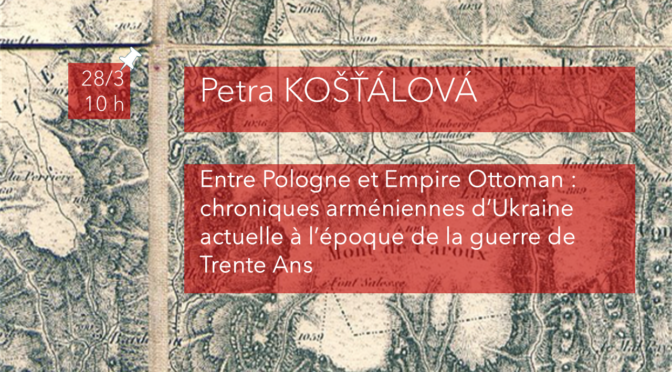Between Poland and the Ottoman Empire: Armenian Chronicles from Ukraine during the Thirty Years’ War
Fifth session of the 2024-2025 CEFRES Francophone
Interdisciplinary Seminar The Map and the Border
Already in 2023, we started questionning the very act of bordering and representing (a territory, a period, a trajectory). In short, thanks to the interdisciplinarity of our respective disciplines, we began inquiring into the question of the map and the border.
Location: CEFRES, Na Florenci 3, Prague 1
Date: March 28, 2025, from 10am to 12pm
Language: French
Speaker: Petra Košťálová (Institute of Ethnology , Czech Academy of Sciences)
Discussant: Radu Paun (CERCEC/CNRS) & Laurent Tatarenko (CCFEF, Warsaw)
Abstract
The contribution entitled ‘Between Poland and the Ottoman Empire: Armenian Chronicles from Ukraine at the Time of the Thirty Years’ War’ focuses on the chronicles of the Armenian diaspora dating from the sixteenth and seventeenth centuries and originating from the territory of Poland-Lithuania (known as the Republic of the Two Nations or Rzeczpospolita). The texts are written either in Armenian of the period, or in the Turkish language, a Kipchak variant (Armenian-Cumanian, Armenian-Kipchak).
Discourse analysis will focus in particular on the chronicles and colophons of Lviv (Simeon Lehatsi), the chronicles of Kamianets Podilskyi (Oksent and John Kamenatsi) and Kaffa (Khatchatur Ghrimetsi), and so on. The above-mentioned sources could provide a perspective for understanding the turbulent period of the Thirty Years’ War, the Ottoman campaigns against the Rzeczpospolita and Sweden’s subsequent interventions in the regions of Central Europe, known as the “Second Northern Wars”. Together with the ‘minor’ chronicles written by Simeon Lehatsi/Simeon of Poland (from the perspective of Zamość and Lviv), the war memories of the Armenian priests of Kamianets or Kaffa of Crimea reveal the complicated history of this specific region and further contribute to the emergence of the symbolic space of the Armenian diaspora. Moreover, these chronicles correspond to the period known as the Great Flight (perceived within the framework of Ottoman history) and to the period of the ‘Little Ice Age’ from the Eurasian perspective – highlighting the permeability of borders (or the importance of threshold/liminality), including some interesting ethnographic aspects and revealing some codified common loci.
Textual analysis of primary sources from a comparative historical perspective can be fruitful not only for historians, but also for ethnologists, anthropologists, experts in the history of religions, linguists, researchers in the field of comparative literature and many others. Armenian chronicles and colophons from the territory of the Rzeczpospolita, whose rich production witnessed the heyday of Lehahayer (Polish Armenians) in the 16th and 17th centuries, could give the reader an insight into the daily life of the Armenian diaspora in cities such as Lviv/Lemberg, Kamianets Podilskyi or Zamość. To this day, preserved Armenian datastan (court) records include numerous wills, commercial contracts, prenuptial agreements etc. In addition to this, Polish Armenians also wrote – thanks to its book cult and emphasis on historiography – chronicles, colophons as well as travelogues. These sources offer a great deal of interesting information about the specific position of the Lehahayer community within Polish urban centres, its struggle to retain its former privileges, its collaboration and rivalry with other minorities (Jewish, Greek) and the majority (mainly Polish and German bourgeois).
In general, primary sources may also include features (of interest to anthropologists) such as the depiction of the exorcism of evil spirits from a woman’s body in the post-partum period, the appearance of werewolves, the description of 17th-century miracles or the search for asylum and rescue of a condemned man from the gallows by a young girl throwing her veil over him (later ‘mediatised’ by the writer Henryk Sienkiewicz in his famous book The Teutonic Knights). The chronicles of Oksent and Hovhannes of Kamianets include a detailed account of the battle of the fortress of Khotin between the Ottoman forces and the armies of the Rzeczpospolita. At the same time, this battle is recounted in the contemporary chronicles of Polish nobles. The chronicles are set against the backdrop of the Thirty Years’ War, the period of the Ottoman “Great Flight” and the wider context of the Little Ice Age. These chronicles can also be seen as indispensable sources not only in the formation of Ukrainian and Polish history, but also in the wider context of Central and Eastern Europe and the Balkans.
About the author
Doc. Petra Košťálová, Ph.D., is a graduate of Armenian Studies and Ethnology (Charles University, Prague). She currently works as an assistant professor at the Department of Eastern European Studies (Charles University). Her research focuses on ethnicity, stereotypes and collective memory, with an emphasis on the Caucasus region (in particular Armenian history, literature and culture). Her main area of research is the textual analysis of Armenian primary sources dating from the sixteenth to eighteenth centuries (chronicles, colophons, travel accounts). She is the author of the following monographs: The Stranger On the Road: Simeon from Lviv as the First Known Backpacker Travelling to Ottoman Empire (2024, in English), Simeon of Poland, Travelogues 1608-1618 (2016, in Czech), The Armenian Chronicles of the Region of the Lake Van, 16th-18th Centuries (2011, in Czech), Stereotypical Images and Ethnic Myths: Cultural identity of Armenia (2012, in Czech), L’image de l’Autre dans les chroniques arméniennes (2010, in French) and Songs of the Country Naïri (2006, in Czech) ; co-author of Catastrophe of the Christians: the extermination of Armenians, Assyrians and Greeks in the Ottoman Empire, 1914-1923 (2017, in Czech) and History of Armenia (2023, in Czech).
See the complete program of the 2024-2025 seminar here.

